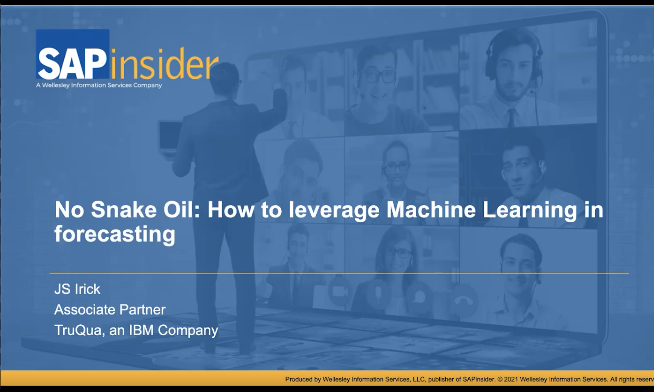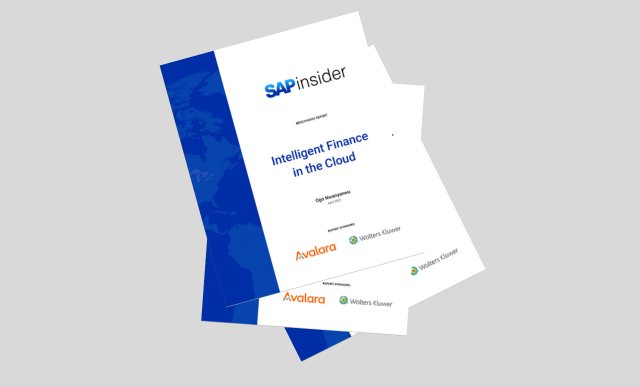Drive Finance Automation with Continuous Innovation Culture
By Ogo Nwanyanwu, Research Director, SAPinsider
Digital transformation often starts with financial automation. Finance and accounting teams that embrace a “culture of continuous innovation,” are well-positioned to drive process optimization in support of financial automation adoption.
Explore related questions
Key Takeaways:
- Organizations are adopting financial automation to manage increased complexities and demand facing today’s finance function
- End-to-end financial process automation adoption is now a critical component of engaging a finance/accounting workforce that wants to add value with technology
- By prioritizing a “culture of continuous innovation,” organizations can reduce barriers to positive outcomes from financial automation and realize quicker ROI from digital transformations.
Automation of Finance Function to Support Remote Workforce
Organizations of all sizes continue to navigate workforce challenges due to COVID-19 and its impact on society. Employees are burned out from high workloads and low job satisfaction, despite the shift to a virtual work environment. Finance and accounting teams are dealing with the increased workload from rapid organizational change, regulatory complexity, and greater volumes of transactions data to process and analyze. Roughly 2.5% of the U.S. workforce resigned from their jobs in July 2021, as part of a trend referred to as the “Great Resignation.” To mitigate potential workforce retention issues, organizations are turning to automation to help reduce workloads and errors from manual processes, creating opportunities for high-value work.
Data from our, SAPinsider Process Automation report, suggests survey respondents are prioritizing the need to improve accuracy and efficiency in business processes (45%), the need to reallocate workforce to higher value tasks (36%) and the need for visibility throughout the business (30%), as the top 3 factors driving process automation across organizations.
For CFOs, the sheer breadth and uniqueness of business activity and transactions in the current operating landscape is unprecedented. As a result, core accounting functions, including financial close, record to report, and order-to-pay, increased in complexity and workload. The financial close cycle represents one of the most demanding functions for accounting teams at large organizations. Working and collaborating virtually (ie – more conference calls, emails, remote work disruptions), while managing the financial close cycle adds another layer of difficulty. Yet, organizations attempting to return employees back to the office or transition to permanent hybrid work protocols face significant employee dissatisfaction and high turnover potential. These challenges, among other workforce issues, represent a significant headwind for senior leaders evaluating or implementing financial automation strategies.
To provide insight on how decision makers can rethink workforce challenges in support of their organization’s financial automation strategy, SAPinsider sat down with Michael Ross, Chief Product Officer at Trintech. Ross leads a product management team of 25 professionals dedicated to creating solutions for enterprise/mid-market organizations. Trintech’s finance automation tools, Adra, RPA & Journal Management, and Cadency, are SAP certified solutions, providing extensions for SAP ERP and SAP S/4HANA deployments.
Link to Video TechInsight: Video Q &A with Michael Ross, Chief Product Officer, Trintech
Shift Workforce to High-Value Tasks with Financial Process Automation
During the conversation, Ross highlighted current themes emanating from Trintech customers and partners to elevate the SAPinsider community’s understanding of how workforce challenges can impact a CFO’s financial automation strategy. Managing reconciliations across every sub-company or unit is extremely labor intensive under normal business conditions and standard work environments. The accelerated pace of corporate transactions such as acquisition, divestitures, mergers, spin-offs, etc only adds to the complexity. Many transactions were the result of C-suites quickly launching new business models in the digital economy. This led to larger organizations acquiring young companies with e-commerce or online focused operating structures, supported by technology-enabled accounting teams.
Many experienced accounting professionals at large organizations still depend on spreadsheets and manual processes for labor-intensive, record to report and reconciliation activities. Despite an increase in core accounting tasks, they remain hesitant to shift workloads to automated processes, fearing errors in the near-term and job insecurity over the long-term. Yet, accounting teams, working and collaborating virtually (ie – more conference calls, emails), had less time for manual processes, potentially crowding out high-value tasks. Ross notes some customers expect their accounting teams to operate remote indefinitely, saying, “We’ve actually heard from a number of our customers that they’re no longer going back to the office. I was meeting with a customer in Dallas last week at a large Fortune 50. A high-tech manufacturer who basically said, ‘you know the accounting office is not going back right?’ “
For organizations, yet to automate core financial and accounting functions, virtual and hybrid work environments can potentially uncover:
- Insufficient governance and controls
- A lack of data harmonization and standardization
- An inability to effectively manage a transitory spike in manual workloads
- Difficulty navigating spreadsheets, macros and point solutions over conference calls
The new workforce, comprised of young finance and accounting professionals, only know a world where innovations, such as smart phones and mobile apps with chat bots, improve their quality of life. Ross adds, “They (young professionals) want to add value with technology, they do not want to fight technology. They want to have the data right the first time. They want to be able to make good decisions quickly and do their task quickly.” Any delta in trusting innovation within an organization’s workforce can be an impediment to implementing financial automation.
Our research confirms workforce challenges as a key factor in driving automation within finance and accounting business units. Narrowing the survey respondents from the SAPinsider Process Automation report by role, we see finance and accounting professions elevate the need to reallocate finance/tax related workforces to higher value tasks (50%) compared to all respondents (36%), as the most important factor driving process automation within their lines of business. Ross brings real-world context to the data, commenting, “GSK, who is a large customer of ours, was able to look at the risk profiles across their balance sheet and redistribute the work.” Cadency facilitated GSK’s ability to automate low-risk reconciliations, allowing their accounting team to focus higher-risk workloads. This represents a clear example of how organizations are increasingly addressing workforce challenges by prioritizing financial process automation within core accounting functionality.
Standardization provides the path Intelligent Financial Automation
Leveraging automation to improve financial close cycles and reduce the workload of your accounting team is critical for financial transformation strategies. By standardizing journal entries and reducing the need for manual reconciliations in spreadsheets, CFOs can improve controls around core accounting workflows. This can set the stage for data-driven, intelligent automation across end-to-end financial workflows. Ross confirms, “We talked about risk, Intelligent RPA, financial controls, AI, ERP bots, smart bots, right? They can do just all types of things, whether it’s adjusting their journal entries and automating them based on materiality. Doing that for your reconciliation, pulling in data from other third-party systems and automatically posting it for you. There is just a suite of advanced automation that we can do, once you’ve got your controls in there.”
The challenge of standardizing journal entries often originates from varied data collection and extraction functions across multiple ERP systems and ledgers, sourcing from several bank accounts. Accounting teams navigating a complex technology landscape often require high levels of customization. For C-suites evaluating financial transformation strategies to help standardize data, integrating accounting automation technology, such as Cadency, should be considered within the context of your SAP S4/HANA journey.
Evaluating Legacy Customizations in SAP S/4HANA Transition
Any evaluation of SAP S/4HANA requires an analysis of existing customizations and whether to support them in the new deployment. Consolidating Organizations must prioritize identifying and removing bad or inefficient processes. The goal is to automate the right processes and reduce time to complete reconciliations, reduce errors and reduce rework. While it is important to consider overall scope of digital transformations, C-suites can target an initial financial automation strategy with SAP S/4HANA and Central Finance. Ross suggests that organizations target deployment stabilization phase and automation optimizations. Avoid lengthy evaluation phases that may prevent your organization from attaining visibility and transparency. He says, “I’ve been working with a large manufacturer and retailer of clothing, and they’ve been struggling with that transformation for five years, because they started questioning everything.”
Global organizations can target SAP S/4HANA and Central Finance to accelerate their financial transformation journey, minimize risk and optimize ROI. The adoption of a universal journal can drive data standardization and empower accounting automation tools teams boost efficiency and accuracy, thus reducing financial statement risk. These achieved benefits can successfully position global organizations to implement a culture of continuous innovation and improvement, capable of supporting today’s technology-engaged workforce.
What Does This Mean for SAPinsiders?
Every organization will have unique requirements to support their financial process automation strategy and building a technology-engaged workforce should be part of the roadmap to intelligent automation and AI-driven modeling. To accelerate your organization’s technology adoption maturity schedule, SAPinsiders should consider these lessons when evaluating workforce challenges:
Implement better controls and governance for your current workforce. Today’s professional changes their employer more frequently, therefore it is important for organizations to both simplify and codify governance and controls that can help align a technology-engaged workforce. Better controls support accounting teams with an improved record-to-report process and compliance awareness.
Place deep lines of business domain experience at the top of innovation. Financial process automation requires constant testing, remediation and improvement from professionals that can leverage specific use-cases and technical finance/accounting expertise to drive innovation and provide insights that support intelligent automation.
Prioritize expert influencers to generate sponsorship and create cross-functional alignment. Organizations can streamline their financial process automation roadmap by elevating professionals that possess the skills to link technical requirements with business needs and provide influence as a potential early adopter. With better collaboration between IT and domain experts, decision makers can achieve cross-functional alignment during the planning stages.





